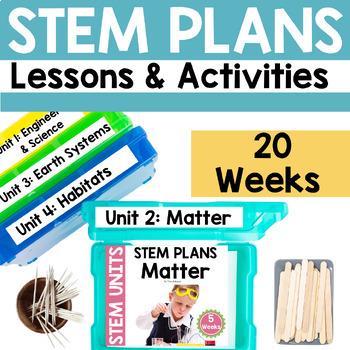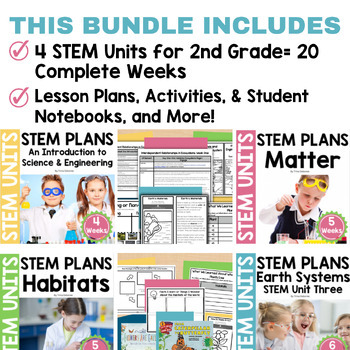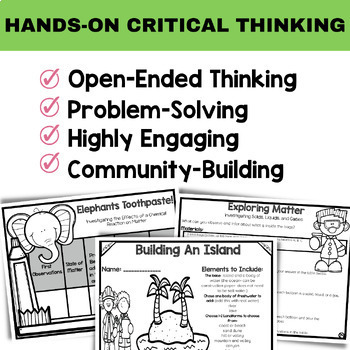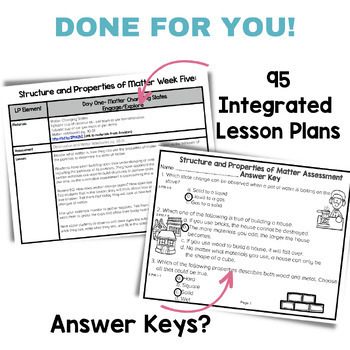STEM Units 2nd Grade: Science COMPLETE YEAR Grade 2 Activities & STEM Challenges
- Zip
- Easel Activity
What educators are saying
Products in this Bundle (5)
Description
STEM Units of Study Bundle Using the 5E model includes FOUR STEM Units of Study with 90 activities, lesson plans, challenges, inquiries, science, engineering, technology, math, and literature integration, as well as a complete curriculum to teach each unit. These units are aligned to NGSS (The Next Generation Science Standards.)
Each unit is four-six weeks of STEM for your second graders. Each day focuses on the 5E model and provides you with the exact tools to illustrate the concepts. All of the guesswork has been removed with this unit of study.
⭐️ All four units are included in this bundle.
⭐️ Unit 1: Unit One Introduction to Science and Engineering
After completing this unit, your students will be able to compare and contrast science and engineering fields of study, work productively in your STEM lab or classroom, determine necessary tools for use, better understand scientific inquiry and the engineering design model, as well as successfully work through STEM challenges.
★ Included in the first 5E unit of study:
• ✓ Big Picture Broken Down- Second Grade Quarterly STEM Topics
• ✓Unit One Overview
• ✓Possible Structure for STEM 5 Day or 3 Day
• ✓Unit 1: An Introduction to Science and Engineering {complete with performance expectations, disciplinary core ideas, science and engineering practices, crosscutting concepts, essential questions, vocabulary, and materials needed)
• ✓Lesson Plans for Each Unit
• ✓Student Activities
• ✓ Science and Engineering Student Notebook (with options for less paper)
• ✓STEM Challenges
• ✓Vocabulary
• ✓Tool Sorts
• ✓Compare and Contrast Science and Engineering
• ✓Nonfiction Text with questions and integration of ELA standards
• ✓Background Information {inducing purpose for the shift from science to STEM, science and engineering practices overview, science and engineering practices broken down by grade level K-5, and science topics K-5}
• ✓Assessment- tool sorts, exit tickets, questions to nonfiction text, science and engineering notebook responses, and project designs
★Weekly Breakdown
Week One:
Procedures and Routines in the Science/STEM/Engineering/Makerspace Classroom
Nonfiction Passages on Introduction to Science and Engineering
Questioning like a scientist and engineer
Literacy Connections: Ava Twist, Scientist and Rosie Revere, Engineer
Week Two:
Engage/Explore: Nonfiction Passages on Science and Engineering Tools
Explain/Elaborate/Evaluate: Academic Vocabulary/Sorts
Engage: Ask, Imagine, and plan a solution for a pool (STEM/Makerspace Challenge)
Explore: Create the solution
Explain/Evaluate: Reflect and Improve Upon Solutions and Share- Compare and Contrast solutions
Week Three:
Engage/Explore: Literature Connection- Questions, Questions and creating lookers in nature
Explain/Elaborate/Evaluate: Nonfiction passages on Science Inquiry and Thinking Like a Scientist
Engage/Explore: Literature Connection- The World is Waiting for YOU
Explain/Elaborate/Evaluate: Nonfiction reading passages on the Engineering Design Process and Thinking Like An Engineer
Engage/Explore: Literature Connection- Iggy Peck, Architect
Week Four:
Engage/Explore: Nonfiction Engineering and Science Safety
Explain/Elaborate/Evaluate: Comparing and Contrasting Scientists and Engineers
Engage/Explore: Ask, Imagine, and Plan Waterslide Challenge
Explore: Create Solution
Explain/Evaluate: Share out and Reflect Upon Improvements to Waterslide
Informational Text Standards Covered:
RI.1 Asking and Answering Questions
RI.4 Vocabulary
RI.5 Text Features
RI.7 Images
⭐️ Unit 2: Structure and Properties of Matter
After completing this unit, your students will be able to:
•2-PS1-1: Plan and conduct an investigation to describe and classify kinds of materials by their observable properties.
•2-PS1-2: Analyze data to determine which materials have the properties best suited for an intended purpose
•2-PS1-3: Make observations to construct an evidence-based explanation of how an object made of a small set of pieces can be taken apart to make a new object, as well as explain that small parts make a whole.
•2-PS1-4: Provide evidence that some changes caused by heating or cooling can be reversed and some cannot.
•K-2-ETS1-1 Ask questions, make observations, gather information to solve a problem through 2 Stem Challenges
•K-2-ETS1-2 Develop a model to explain a solution to a problem
★ Included in the second 5E unit of study:
• ✓ Big Picture Broken Down- Second Grade Quarterly STEM Topics
• ✓Unit Two Overview
• ✓Unit 2: Structure and Properties of Matter {complete with performance expectations, disciplinary core ideas, science and engineering practices, crosscutting concepts, essential questions, vocabulary, and materials needed)
• ✓Lesson Plans for Each Unit
• ✓Student Activities
• ✓Science and Engineering Matter Student Notebook (with options for less paper)
• ✓STEM Challenges
• ✓Learning Investigations
• ✓Vocabulary
• ✓Original Informational Text Readers on Matter Topics
• ✓Trade book Suggestions with Literacy Connections
• ✓Nonfiction Text with questions and integration of ELA standards
• ✓Background Information {inducing purpose for the shift from science to STEM, science and engineering practices overview, science and engineering practices broken down by grade level K-5, and science topics K-5}
• ✓Assessment- matter quiz, questions to nonfiction text, science and engineering matter notebook responses, project designs, and final summative assessment
★Weekly Breakdown
Week One:
Engage: What is the World Made Of? All About Solids, Liquids, and Gases by Kathleen Weidner Zoehfeld
Explore: An Introduction to Matter Learning Investigation/Experiment with Mixtures/Solutions
Explain: Matter Explained (Your Choice Tradebook/suggested materials or Matter, Matter, Everywhere! By Trina Deboree
Elaborate: Mixtures/Solutions Learning Investigation/Experiment
Evaluate: Matter Quiz (formative assessment)
Week Two:
Engage/Explore Properties of Matter Pirates Adventure App
Explain: Nonfiction Passages on Properties of Matter/Vocabulary with ELA questions
Engage/Explore: Sinking and Floating Challenge {Ask and Imagine}
Explore/Elaborate: Sinking and Floating {Create} Build
Elaborate/Evaluate Sinking Floating Challenge {Revise and Improve{ Present- compare and contrast
Week Three:
Engage/Explore: Close Read Iggy Peck, Architect {Literacy Connection} Building Structures Using Small Materials to Create and Recreate a whole. {Ask/Imagine/Plan}
Explore: Create and discuss structures
Explain/Elaborate: Video link to 100 Most Famous Buildings/Structures of All Time and Matter in Architecture by Trina Deboree (included)
Evaluate: Revise Structures {Revise and Improve}
Week Four:
Engage: Literacy Connection - What's the Matter In Mr. Whisker's Room?
Explore/Explain: States of Matter Learning Investigation (experiment)
Explain: How Does Matter Change? Nonfiction passages/ELA questions
Explain/Elaborate: Motion of Particles (observations with movement- learning investigation)
Explore/Explain/Elaborate: Particles in Gas Learning Investigation
Week Five:
Engage/Explore: Matter Changing States and Temperature Learning investigation (experiment)
Explain/Elaborate: Solids, Liquids, Gases, and Temperature by Trina Deboree (provided)
Explain/Elaborate: Class Demonstration Chemicals React (Elephant's Toothpaste)
Evaluate: Review for Summative
Evaluate: Summative Assessment
Informational Text Standards Covered:
RI.1 Asking and Answering Questions
RI. 2 Main Idea
RI. 3 Connections to Scientific Concepts
RI. 4 Vocabulary
RI. 7 Images
⭐️ Unit 3: Earth Systems: Processes That Shape the Earth
After completing this unit, your students will be able to:
•2-ESS1-1: Use information from several sources to provide evidence that Earth events can occur quickly or slowly.
•2-ESS2-1: Compare multiple solutions designed to slow or prevent wind or water from changing the shape of the land.
•2-ESS2-2: Develop a model to represent the shapes and kinds of land and bodies of water in an area.
•2-ESS2-3: Obtain information to identify where water is found on Earth and that it can be solid or liquid.
•2-PS1-1: Plan and conduct an investigation to describe and classify different kinds of materials by their observable properties.
•K-2-ETS1-1 Ask questions, make observations, gather information to solve a problem through 4 Stem Challenges
•K-2-ETS1-2 Develop a model to explain a solution to a problem
★ Included in the third 5E unit of study:
• ✓ Big Picture Broken Down- Second Grade Quarterly STEM Topics
• ✓Unit Three Overview
• ✓Unit 3: Earth Systems: Processes That Shape the Earth {complete with performance expectations, disciplinary core ideas, science and engineering practices, crosscutting concepts, essential questions, vocabulary, and materials needed)
• ✓Lesson Plans for Each Unit
• ✓Student Activities
• ✓Science and Engineering Earth Systems Student Notebook (with options for less paper)
• ✓STEM Challenges
• ✓Learning Investigations
• ✓Vocabulary
• ✓Original Informational Text Readers on Earth's Materials and Landforms
• ✓Trade book Suggestions with Literacy Connections
• ✓Nonfiction Text with questions and integration of ELA standards
• ✓Background Information {inducing purpose for the shift from science to STEM, science and engineering practices overview, science and engineering practices broken down by grade level K-5, and science topics K-5}
• ✓Assessment- rock quiz, questions to nonfiction text, science and engineering Earth Systems notebook responses, project designs, and final summative assessment
★Weekly Breakdown
Week One:
Engage: Earth's Materials by Trina Deboree (included) {Literacy Connection}
Explore: An Introduction to Water {Investigation/Experiment}
Explore/Explain: How Does Water Change on Earth? {Investigation/Experiment}
Explain/Explain: Where is Water on Earth? {Technology Connection and Math-Graphing}
Explain/Elaborate: Water Cycle {Technology}
Week Two:
Engage/Explore Ricky the Rock That Could Not Roll by Jay Miletsky {Makerspace Moment in Literature STEM Challenge}
Explore: Build Rock Rollers/Investigate properties of rocks {Makerspace/STEM included}
Explain: Nonfiction Passages on What Makes Up the Earth and What Can You Observe About Rocks?/Vocabulary with ELA questions {Lit connection}
Elaborate: Nonfiction Passage: What Factors Can Form and Change Rocks? {Lit connection}
Evaluate: Rock Quiz (Summative Assessment)
Week Three:
Engage/Explore: An Introduction to Earth's Materials- Sand (Investigation) {Tech and ELA}
Explore: Investigating How Water Can Change Sand- Investigation/Experiment
Explain: Nonfiction passage: How Sand is Formed {Lit and Science}
Elaborate/Explore: How Can Wind Change Sand? Nonfiction Passage {Lit/Science}
Evaluate: How Can We Design a Barrier to Reduce Wind Erosion? {Engineering}
Week Four:
Engage/Explore: Literacy Connection - Food Warning by Katherine Keneah Makerspace Building a Dam
Explore/Exnage: Designing the Dam
Explain: Studying Soil Nonfiction passages/ELA questions {Lit connection}
Elaborate: What Can We Learn by Studying the Soil- Dirt the Scoop on Soil by Natalie Rosinsky {Lit connection}
Evaluate: Reduce Soil Erosion {Nonfiction passage/lit connection}
Week Five:
Engage/Explore: How Do Glaciers Change Land? (experiment) {Tech integration}
Engage/Explore: How Do Rivers Change Land/ Experiment
Explain: Studying Landforms Nonfiction Passage {lit connection}
Elaborate: Studying Landforms: Nonfiction text by Trina Deboree (included) {lit connection}
Catch-Up Time
Week Six: (Summative Project and Assessment)
Engage: Ask questions about making a model island
Explore: Build the Island
Explain: Revise the island
Elaborate: Review for Summative Assessment
Evaluate: Summative Assessment
Informational Text Standards Covered:
RI.1 Asking and Answering Questions
RI. 3 Connections to Scientific Concepts
RI. 6 Author's Purpose
RI. 4 Vocabulary
RI. 7 Images
⭐️ Unit Four: Interdependent Relationship in Ecosystems {Habitats}
After completing this unit, your students will be able to:
• 2-LS2-1: Plan and conduct an investigation to determine if plants need sunlight and water to grow.
• 2-LS2-2: Develop a simple model that mimics the function of an animal in dispersing seeds or pollinating plants.
• 2-LS4-1: Make observations of plants and animals to compare the diversity of life in different habitats.
• K-2-ETS1-2: Develop a simple sketch, drawing, or physical model to illustrate how the shape of an object helps it function as needed to solve a given problem.
• K-2-ETS1-3: Analyze data from tests of two objects designed to solve the same problem to compare the strengths and weaknesses of how each performs.
★ Included in the fourth 5E unit of study:
• ✓Big Picture Broken Down- Second Grade Quarterly STEM Topics
• ✓Unit Four Overview
• ✓Unit 4: Interdependent Relationships in Ecosystems {complete with performance expectations, disciplinary core ideas, science and engineering practices, crosscutting concepts, essential questions, vocabulary, and materials needed)
• ✓Lesson Plans for Each Unit
• ✓Student Activities
• ✓Science and Engineering Ecosystem Student Notebook (with options for less paper)
• ✓STEM Challenges
• ✓Learning Investigations
• ✓Vocabulary
• ✓Original Informational Text Readers on Where Do Plants and Animals Live?, What Are Different Types of Habitats? What Do Plants and Animals Need to Survive? How Do Plants and Animals Depend on Each Other, and How Plants Grow
• ✓Trade book Suggestions with Literacy Connections
• ✓Nonfiction Text with questions and integration of ELA standards
• ✓Background Information {inducing purpose for the shift from science to STEM, science and engineering practices overview, science and engineering practices broken down by grade level K-5, and science topics K-5}
• ✓Assessment- questions to nonfiction text, science and engineering Ecosystem notebook responses, project designs, and final summative assessment
★Weekly Breakdown
Week One:
Engage: KWL What is an Ecosystem and What is Biodiversity? {Tech integration- Dr. Binocs Show}
Explore: Exploring Living and Nonliving Things and Land and Water Sort {Investigation}
Explore/Explain: Where Do Plants and Animals Live? {Literature Connection/Information Text- Included}
Explain: What are Different Types of Habitats? {Literature Connection/ Information Text- Included}
Elaborate/Evaluate: What Do Plants and Animals Need to Survive? and How Do Plants and Animals Depend on Each Other? {Literacy Connection/ Information Text- Included}
Week Two:
Engage: Introduce Plant Locations {Literacy Connection/ Information Text- Included}
Explore: What Do Plants Need to Grow {Investigation: Science and Math Integration}
Explain/Elaborate/Evaluate: How Do Plants Grow? {Research and Share- Tech and literacy integration}
Explore/Evaluate: Investigating 5 Plants {Science and Math Integration}
Week Three:
Engage: How Do Plants Grow? {Literacy Connection}
Explore: What Do We See?- {Investigation/Experiment}
Explain: What is Pollination? {Literacy Connection}
Elaborate/Explore: Pollinator Design Challenge {STEM Challenge/Science and Engineering}
Evaluate: Design Challenge
Week Four:
Engage: Diversity in Habitats {YouTube- Tech Integration}
Explore/Explain: Research Habitat Diversity {Literacy Connection/Tech Integration}
Elaborate: From Caterpillar to Butterfly {Lit connection}
Elaborate/Evaluate: Caterpillar Habitat {Engineering Design Model Challenge}
Week Five:
Engage: The Garbage Pile and How Much Trash {Tech Integraion}
Explore/Explain: What's In the Trash? {Investigation and Literacy Connection}
Elaborate: Why Should We Recycle? {Literacy Connection}
Elaborate: Review for Summative
Evaluate: Summative Assessment
Informational Text Standards Covered:
RI.1 Asking and Answering Questions
RI. 2 Main Idea
RI. 3 Connections to Scientific Concepts
RI. 4 Vocabulary
RI. 5 Text Features
RI. 6 Author's Purpose





